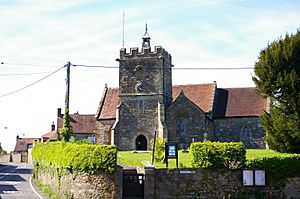Church of St Mary, Abbas and Templecombe facts for kids
Quick facts for kids Church of St Mary |
|
|---|---|
 |
|
| Location | Templecombe, Somerset, England |
| Built | 12th century |
|
Listed Building – Grade II*
|
|
| Official name: Church of St. Mary | |
| Designated | 24 March 1961 |
| Reference no. | 1366329 |
| Lua error in Module:Location_map at line 420: attempt to index field 'wikibase' (a nil value). | |
The Church of St Mary is an old and important church located in Templecombe, a village in Somerset, England. It was built a very long time ago, in the 1100s! This church is so special that it's officially recognized as a Grade II* listed building, which means it's a very important historic place.
The church is part of a group of churches in the area, including those in Abbas, Henstridge, and Horsington. They all work together under the guidance of the Wells church leaders.
Contents
History of the Church
One part of the land where the church stands used to belong to a powerful earl named Leofwine. After the Normans took over England, this land was given to Bishop Odo. The church was likely started when the land was owned by Shaftesbury Abbey.
Later, the land was given to the Knights Templar, a famous group of warrior monks. They built a special center called a "preceptory" in the village in 1185. This center helped them manage their lands in the southwest of England and Cornwall. It might have also been a training place for knights and horses going on Crusades, which were religious wars.
After the Knights Templar were disbanded in 1307, the church and land went to another group of knights, the Knights of St John. They kept it until the time when many monasteries were closed down in England.
Changes Over Time
Some parts of the original church from the 1100s are still there today. However, the church had a big makeover in the 1800s. This included completely rebuilding the chancel (the area around the altar) and adding a vestry (a room for clergy). The very bottom parts of the church tower might even be from an earlier time, when the Saxons lived here.
The church was also damaged during World War II. In 1940, four bombs fell near the church. This damaged some of the arches inside, the roof, and the tower. It also broke some windows and harmed the church organ.
Church Design and Features
The Church of St Mary is built from stone, with special local stone called Hamstone used for decoration. Its roofs are made of clay tiles. The church has a main hall called a nave and a smaller section called a chancel. There's also a south transept, which is like a wing extending from the main part.
The main entrance is through a porch at the bottom of the church's two-story tower. The strong supports on the outside walls, called buttresses, were added after the tower was built.
Church Bells
The church tower holds several old bells. The oldest bell was made around 1420. Two other bells were made in 1656 by Robert Purdue. Two more bells from 1736 were made by the Bilbie family, who were famous bell makers. The newest bell was added in 1891.
Churchyard Memorials
In the churchyard, there is a stone cross that stands about 15 feet tall. This cross is a war memorial for the village, honoring those who served. The churchyard also has four graves looked after by the Commonwealth War Graves Commission. These are for two British Army soldiers from World War I and an airman and a woman from the WRNS from World War II.
Inside the Church
Inside the church, you'll find a font made from Purbeck Marble in the 1100s. The cover for the font was added much later, in 1897. The church also has some old and valuable silver items used in services. These include a cup from 1628, two serving dishes from 1725, and a large jug from 1845.
The Templecombe Head Painting
One of the most interesting things inside the church is a painting of a head on wooden boards. This painting was found in 1945 in the roof of a small building next to a local house. A person living there was collecting wood when part of the ceiling fell. They looked up and saw a face painted on a wooden panel, held by wire to the roof.
Experts believe the painting is from the 1200s. It is thought to be connected to the Templecombe Preceptory, the Knights Templar center established in the village in 1185. The painting was given to the church in 1956.
When the painting was cleaned and studied in the 1950s and again in the 1980s, tiny gold stars were found on it. There was also evidence of bright colors that are no longer visible. The colors were present when it was first found, but they faded when a local vicar tried to clean it with a strong cleaning product. The painting also has a keyhole and hinges, which suggests it might have been used as a door at some point.
For many years, people have thought the head might be a painting of Christ. However, it doesn't have a halo, which was usually shown in religious art at that time. Some people have even wondered if it's connected to the Shroud of Turin. Other ideas suggest the painting is not of Christ, but of John the Baptist.
See also
- List of ecclesiastical parishes in the Diocese of Bath and Wells

